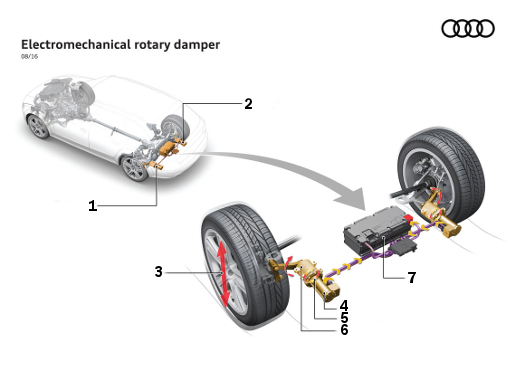 |
| August 23, 2016 | Volume 12 Issue 32 |
Designfax weekly eMagazine
Archives
Partners
Manufacturing Center
Product Spotlight
Modern Applications News
Metalworking Ideas For
Today's Job Shops
Tooling and Production
Strategies for large
metalworking plants
Wheels:
Audi works on energy-harvesting active-damping suspension
We've all hit a bump in the road at some time. Audi wants that experience to be a little more cushy -- and a little less drain on your fuel tank if you have an active-suspension system.
Because recouping energy plays an increasingly important role in designs for mobility, including in a car's suspension, Audi is working on a prototype called "eROT," where electromechanical rotary dampers replace the hydraulic dampers used today for a more comfortable ride.
The principle behind eROT is easily explained: "Every pothole, every bump, every curve induces kinetic energy in the car. Today's dampers absorb this energy, which is lost in the form of heat," says Stefan Knirsch, Audi's chief of R&D. "With the new electromechanical damper system in a 48-volt electrical system, we put this energy to use. It also presents us and our customers with entirely new possibilities for adjusting the suspension."

1, 2. Electromechanical rotary dampers. 3. Vertical force induced by road unevenness. 4. Alternator. 5. Conversion of the movement into electrical energy. 6. Gear unit. 7. 48-V battery.
The eROT system responds quickly and with minimal inertia. As an actively controlled suspension, it adapts easily and immediately to irregularities in the road surface and the driver's driving style. Damper characteristics are definable via software, so the system's functionality covers a wide range of situations and driver preferences. Another plus it that it eliminates the mutual dependence of the rebound and compression strokes that limit conventional hydraulic dampers.
With eROT, Audi configures the compression stroke to be comfortably soft without compromising the taut damping of the rebound stroke. Yet another advantage of the new damper system is its geometry. The horizontally arranged electric motors in the rear axle area replace the upright telescopic shock absorbers, a design that allows for additional space in the luggage compartment.
The eROT system enables a second function besides the freely programmable damper characteristic: It can convert the kinetic energy during compression and rebound into electricity. To do this, a lever arm absorbs the motion of the wheel carrier and transmits this force via a series of gears to an electric motor, which converts it into electricity. The recuperation output is 100 W to 150 W on average during testing on German roads and from 3 W on a freshly paved freeway to 613 W on a rough secondary road.
The new eROT technology is based on a high-output 48-V electrical system (not yet available on the market through Audi). As currently configured, its lithium-ion battery offers an energy capacity of 0.5 kWh and a peak output of 13 kW. A DC converter connects the 48-V electrical subsystem to the 12-V primary electrical system, which includes a high-efficiency, enhanced output generator.
Initial test results for the eROT technology are promising, but a prerequisite for its eventual incorporation into the Audi lineup is the full development of a 48-V electrical system, which is a central component of Audi's evolving electrification strategy. In the next version planned for 2017, the 48-V system will serve as the primary electrical system in a new Audi model and feed a high-performance mild hybrid drive. Audi says it will offer potential fuel savings of up to 0.7 liters per 100 km.
Source: Audi
Published August 2016
Rate this article
View our terms of use and privacy policy
